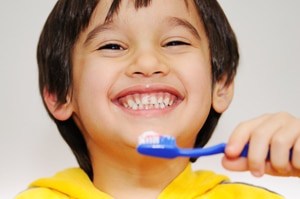 Professionals with dental assistant degrees may help urge children to take advantage of proper dental services, especially during a time when a vast majority of today’s youth are forgoing preventive treatments. According to a Sept. 12 report released by the U.S. Centers for Disease Control and Prevention, millions of infants, children and adolescents in the U.S. are not getting preventive dental services.¹ The report, titled “Use of Dental Care and Effective Preventive Services in Preventing Tooth Decay Among U.S. Children and Adolescents – Medical Expenditure Panel Survey, United States, 2003-2009 and National Health and Nutrition Examination Survey, United States, 2005-2010,” presented a baseline assessment of preventive services prior to 2012, which is before or shortly after implementation of the Patient Protection and Affordable Care Act (ACA). Less than half of children ages 21 and younger (44 percent) used dental care in 2009 and only 14 percent of children of the same ages received a preventive dental service, such as a topical fluoride, sealants or both.¹ Once specialists graduate from dental assistant schools, they can help administer these services to reduce the risk of tooth decay, gingivitis and other oral health problems.
Professionals with dental assistant degrees may help urge children to take advantage of proper dental services, especially during a time when a vast majority of today’s youth are forgoing preventive treatments. According to a Sept. 12 report released by the U.S. Centers for Disease Control and Prevention, millions of infants, children and adolescents in the U.S. are not getting preventive dental services.¹ The report, titled “Use of Dental Care and Effective Preventive Services in Preventing Tooth Decay Among U.S. Children and Adolescents – Medical Expenditure Panel Survey, United States, 2003-2009 and National Health and Nutrition Examination Survey, United States, 2005-2010,” presented a baseline assessment of preventive services prior to 2012, which is before or shortly after implementation of the Patient Protection and Affordable Care Act (ACA). Less than half of children ages 21 and younger (44 percent) used dental care in 2009 and only 14 percent of children of the same ages received a preventive dental service, such as a topical fluoride, sealants or both.¹ Once specialists graduate from dental assistant schools, they can help administer these services to reduce the risk of tooth decay, gingivitis and other oral health problems.
Tooth decay running rampant
Tooth decay is the single most common chronic children’s disease – five times more common than asthma, four times more prevalent than early childhood obesity and 20 times more common than diabetes, according to the American Academy of Pediatric Dentistry.² Children who frequently consume sugary liquids and foods such as soda, fruit juice, artificially flavored candies and other sweets, face a greater risk of suffering from dental caries (cavities). In spite of the prevalence of cavities, the infection is almost entirely preventable. With proper brushing, flossing, diet and routine trips to the dentist, children can fight off caries. Yet numbers on decay are still far too high. About 23 percent of children ages 2-11 years old have at least one primary tooth with untreated decay, and 20 percent of adolescents ages 12-19 have at least one permanent tooth with untreated decay, according to the CDC. What’s more, roughly 1 in every 4 U.S. children do not have dental insurance, either private or public.¹ The report highlighted that very young children (ages 3 and younger) were less likely than older children to use dental care. The American Academy of Pediatrics encourages families to have started a relationship with a dentist by the time their child is 1 year old to deter the development of tooth decay. Thereafter, a child should be seen by a dentist every six months or on the basis of a child’s individual needs.
Intimate link between oral and overall health
As those in dental assistant colleges know, oral health is closely intertwined with systemic health. So, by keeping one’s mouth free of periodontal disease, an individual may reduce the risk of other “big-picture” problems later in life such as cardiovascular disease, diabetes, obesity and even complications during pregnancy.³,⁴,⁵ Scientists believe that inflammation caused by periodontal disease increases one’s chances of developing heart disease, while also exacerbating existing heart conditions.³ Diet plays a big role in staving off tooth decay as well as obesity – the food and drink one consumes affects not only his or her waistline, but also his teeth and gums. Additionally, several studies published in the Journal of Periodontology have found a strong connection between gum disease and pregnancy problems. In particular, gum disease may increase the risk of preterm delivery and babies with low birth weight. For those who think such medical forecasting is looking too far into the future, they might want to reconsider. The dental habits children form at a young age often reflect their habits moving forward into and throughout adulthood. It is thus crucial for certified dental assistants to shed light on how younger patients can access dental services and maintain the tools they need to defend against oral health issues at home. “We must protect the health of all children and ensure that they receive recommended screenings and services. Together, parents and the public health and healthcare communities can work to ensure that children have health insurance and receive vital preventive services,” Dr. Stuart Shapira, chief medical officer and associate director for science in CDC’s National Center on Birth Defects and Developmental Disabilities, said in a statement. “Increased use of clinical preventive services could improve the health of infants, children, and teens and promote healthy lifestyles that will enable them to achieve their full potential.” The CDC report confirmed that clinical interventions, such as dental sealants, fluoride, topical gels and varnishes, and oral fluoride supplementation, are effective in preventing and controlling tooth decay. For this reason, those with a dental assistant diploma can help educate younger patients about the importance of dental care in their everyday health regimen. ¹Griffin, S., Barker, L., Wei, L., Li, C., Albuquerque, M., & Gooch, B. (2014, September 12). Use of Dental Care and Effective Preventive Services in Preventing Tooth Decay Among U.S. Children and Adolescents — Medical Expenditure Panel Survey, United States, 2003–2009 and National Health and Nutrition Examination Survey, United States, 2005–2010. Retrieved September 17, 2014. ²Early Childhood Caries (ECC). (2004, January 1). Retrieved September 17, 2014, from http://www.aapd.org/assets/2/7/ECCstats.pdf ³Gum Disease and Heart Disease | Perio.org. (n.d.). Retrieved September 17, 2014, from http://www.perio.org/consumer/heart_disease ⁴Heart disease and oral health: Role of oral bacteria in heart plaque. (2007, February 7). Retrieved September 17, 2014, from http://www.health.harvard.edu/press_releases/heart-disease-oral-health ⁵Amin, M., & ElSalhy, M. (2013, April 1). Periodontitis and adverse pregnancy outcomes: Consensus report of the Joint EFP/AAP Workshop on Periodontitis and Systemic Diseases. Retrieved September 17, 2014. ⁶Ward, W., & Fritz, P. (2012, October 1). Obesity and Periodontal Health: What’s the link? Should I be concerned? Retrieved September 17, 2014, from http://www.oralhealthgroup.com/news/obesity-and-periodontal-health-whats-the-link-should-i-be-concerned/1001733899/?&er=NA



